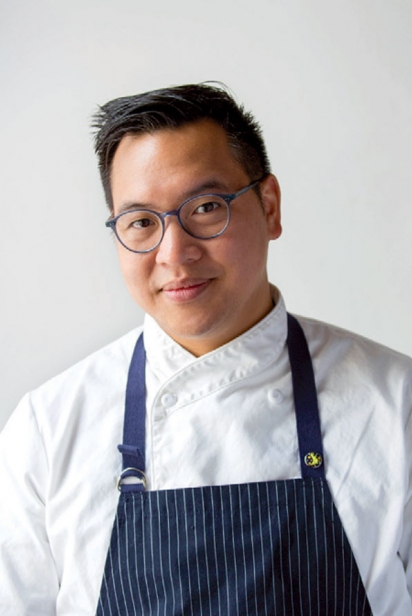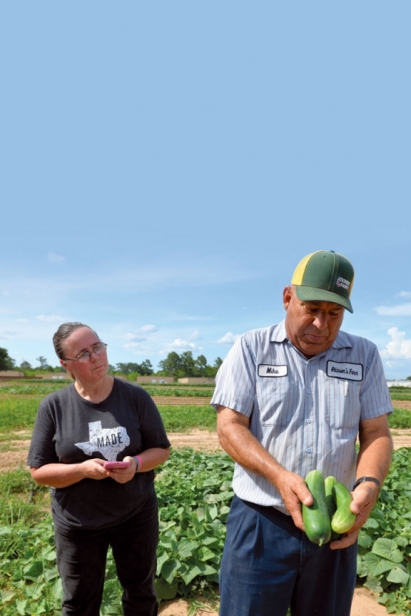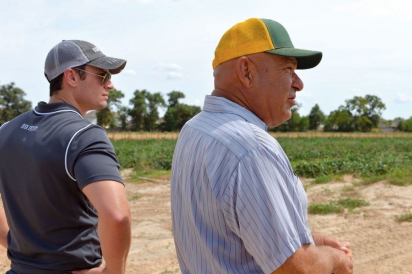Two Houston Restaurants Working To Put Locally Grown on the Menu
Sourcing locally is worth the extra effort but not always that easy
It was neither flash nor fanfare that inspired Aaron Lyons to start a restaurant that serves meals made from local produce. It was hunger for something new.
“There were only a handful of farm-to-table restaurants,” says Lyons of Houston before the entrepreneur opened Dish Society in 2014. “They were James Beard-y—not a place I’d go twice a week when I had 30 minutes for lunch.”
So Lyons opened the kind of place he wanted to see in Houston: a restaurant that balances the farm-to-table menu of a fine-dining establishment with the counter-service vibe of a café. He had a mountain of debt that comes with an MBA and no restaurant experience, but he went with his gut and opened Dish Society. His instincts paid off. In the four years since Lyons started his flagship operation in the Galleria, he’s opened two additional locations around Houston, with two more coming this year.
Sourcing local food for the restaurant is no easy undertaking. Chefs buy food from farmers in constant competition with nature. Torrential rains wipe out entire crops, summer heat means leaner cuts of meat, and every few weeks a new green grows in place of another, making it difficult for chefs to cater to customers who want a consistent menu. “Unless you’re changing your menu every day,” says Lyons, “nobody can really go 100% local.”
Offering a consistent menu packed with local goods is a major challenge when sourcing for three mid-sized restaurants. Lyons changes the menu twice a year to reflect Houston’s cool and warm seasons, but small and midsized family farmers can’t always deliver the amount Lyons needs to stock his kitchens, leaving him to buy ingredients like eggs from national distributors. In spite of shortages, the proprietor manages to keep 75% of what he buys from producers within 200 miles of his restaurants, turning to Austin-area growers when Houston can’t deliver.
Communication breakdowns also cause fractures in the pipeline from local farm to local restaurant. It’s not unheard of for chefs and farmers to get their wires crossed, whether it’s someone who’s forgotten to deliver bush beans or another who’s forgotten to order cucumbers.
Keeping food close to home also requires good relationships between food growers and food cookers. Like all relationships, those take patience. “We’re in this for the long term so we want to build those relationships,” says Lyons. When it comes to the people who grow food for the restaurant, in conversation he prefers the term “partner” to “supplier,” noting a smooth operation hinges on strong partnerships.
Mike Atkinson of Atkinson Farms is one of Dish Society’s favored partners, and the feeling is mutual because Lyons and his team understand the need for flexibility, says Atkinson.
“The weather can beat us up sometimes,” he explains, “and [Dish Society] works with us on that.” Sometimes melons get bruised or potatoes aren’t big enough, but rather than terminate a relationship when inevitable hiccups happen, Dish Society finds a workaround for the week, either through buying from a different farmer or a commercial distributor. Because of that patience, Atkinson explains, he’s better equipped to deliver with the level of quality his family has adhered to since his grandfather started farming in Harris County the 1920s.
Local in the land of James Beard
Meanwhile, just a few miles down the road from the Dish Society flagship location, Justin Yu dishes up locally sourced food that absolutely qualifies as “James Beard-y.” The culinary mastermind of Theodore Rex and Better Luck Tomorrow, Yu won the award for best chef in the Southwest in 2016 for his work at Oxheart, where he and Karen Man made a menu famous for vegetable-forward cuisine. Yu, a Houston native, tries to keep his menu close to home by sourcing the majority of his ingredients from producers within a 200-mile radius. But without a centralized communications mechanism, bags of tarragon or bundles of sorrel can get lost in the shuffle.
“Communication’s tough. Farmers are not the best communicators. That’s probably why they got into farming,” says Yu.
“And honestly, chefs are not the best communicators,” he adds. “That’s probably why they got into cooking.”
Communicating with farmers throughout the week is vital to the success of Yu’s restaurants, but that’s not all he has to worry about. Yu understands the difficulty farmers know painfully well: “[Farmers] are literally at the mercy of what the weather brings them and what the soil brings them.” Even the most skilled stewards of the land can never know for sure what the elements have in store.
Another hang-up for chefs in Houston is the lack of nearby growers and an insufficient selection. “There’s not a lot of farmers in town so not a lot of them can get us orders,” says Yu. Both he and Lyons want to their food to be Houston-grown, but for want of producers they have to venture to the more farm-forward land of Austin.
Yet there’s promise in newer farms like Plant It Forward, Finca Tres Robles and Loam Agronomics. And no discussion of local sourcing in Houston can happen without a nod to Gita Van Woerden, founder of Animal Farm.
If there’s a face to Houston’s local food revival, it’s probably Van Woerden’s sunhat-framed portrait. Known widely as the queen of Houston’s ag scene, Van Woerden puts the farm in farm-to-table dining. When she started her permaculture farm in the early ’90s, “there was no market,” she says. “So we sold only to restaurants.”
She started selling to Monica Pope and other of chefs with Chefs Collaborative 2000, and from there the increase in local food sourcing surged. Yet for all the fuss over local food, the past five years have marked a decline in chef sales and market sales, says Van Woerden. She muses over the possible culprits. Perhaps fewer people are buying local food because it’s cheaper to buy conventional. Perhaps because it’s inconvenient, she speculates, or perhaps people just don’t care.
In the face of difficulty, why bother buying local?
But for chef-owners and restaurateurs like Yu and Lyon, it’s the flavor of fresh food that motivates them to keep local ingredients on hand. Local food offers the palate a zest to swear by, they say, and the spirit of a daikon radish or an early-morning egg is fully understood only when savored as soon as they were plucked from the earth. And customers take notice, too, holding proprietors accountable by demanding quality ingredients.
Yet there’s another element driving consumers’ taste for local. “We expect something that differentiates this experience today with something we had the other day at another restaurant,” says Christopher Taylor, associate professor at the University of Houston College of Hotel and Restaurant Hospitality.
Taylor calls this phenomenon “amenity creep” and says it comes with a cost: having to explain the price tag that comes with a meal made from locally sourced ingredients. “We expect amenities and we don’t expect to pay for them.”
But the food is expensive for a reason. Whether these food producers spend their 70-hour work week hunched over a fire pit or bent over a row of okra, making food is a labor of love that demands strenuous physical effort. And it is not just one farmer or one chef who makes farm-to-table dining a reality. A host of pickers, wait staff and marketing specialists all work to make it possible for Houstonians to relish locally grown food. Some customers may balk at $13 salad or a $20 plate of chicken, but with the cost comes value. That price tag offers assurance that workers are paid for the extensive labor that goes into sustainably sourced food.
In spite of the chefs who put their purchasing power into local ingredients, farmers still aren’t making enough from other major revenue sources to afford the level of expansion that would allow them to consistently satisfy restaurants’ supply needs. Until farmers see an increase in market sales and farm share orders, restaurants like Dish Society will remain limited in how local they can keep their business. “Some of our (nearby) suppliers can’t keep up with our demands so we’re always looking,” says Lyons.
If restaurants are to source more ingredients from local producers, it’s up to customers to put their money where their mouth is.
THE LOCAL HAMMER
Dawn “The Hammer” Prather is Dish Society’s secret weapon. The farmers and the chefs may be the ones who make the food, but Prather’s the one who sees to it that the Dish Society table is set with locally sourced food.
As lunch hour comes to a close, The Hammer is in full swing. She’s been at it since 6am and she won’t stop until 10pm. She whips out her phone and starts tapping at the screen like she’s playing Candy Crush. But Prather’s not playing games: She’s using the restaurant’s specialized communication platform to ensure that everyone in the supply chain is on the same page.
Officially known as the chain’s supplier relations coordinator, Prather is not only a linchpin at Dish Society, she has one of the neatest jobs in town. When she’s not at one of Dish Society’s three locations, she’s scoping out farmers markets across Houston. There she discovers the latest, freshest ingredients and connects with the people who cultivate them.
Another part of her job entails ensuring quality control and minimizing food waste. Prather determines which ingredients are too small or too bumpy for one dish, and calculates how they could be repurposed for another. “There’s no such thing as ugly tomatoes,” she says, noting that what doesn’t make it into a Cobb salad gets thrown into a sauce. With thanks to The Hammer’s brand of diligence, Dish Society is able to uphold sustainable practices across all of its locations.
Prather says she’s dedicated to her work as Dish Society’s sourcer-in-chief, but what really ignites her passion is hospitality. She recounts the time that she organized a watch party for “MasterChef Junior” contestant Henry Hummeldorf’s television debut at Dish Society’s Katy location. Prather met the 10-year-old hot sauce maker on a work trip to the Katy Market and so impressed was she with his work that she had a special ice cream made with the fifth-grader’s HotHead Henry hot sauce.
When it comes to running a local-centric restaurant, the supply chain is just one part of the equation, says Prather. “At Dish Society we try to focus on helping our community and doing things that impact local people,” she says. For restaurants like Dish Society, she adds, local is as much about family as it is about food.









